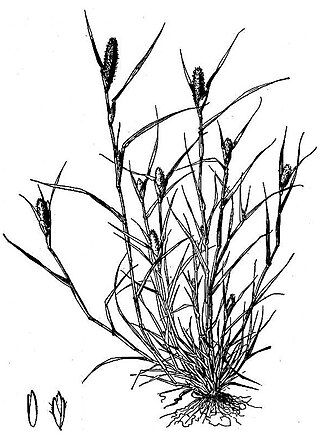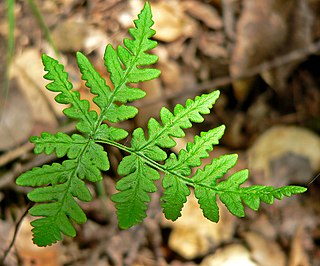
Amsinckia is a genus of flowering plants commonly known as fiddlenecks. The common name is derived from the flower stems, which curl over at the top in a manner reminiscent of the head of a fiddle. Fiddlenecks are in the family Boraginaceae, along with borage and forget-me-nots. The genus is named after the patrician Amsinck family in honour of the Hamburg head of state and patron of botany Wilhelm Amsinck (1752–1831).

Spartina is a genus of plants in the grass family, frequently found in coastal salt marshes. Species in this genus are commonly known as cordgrass or cord-grass, and are native to the coasts of the Atlantic Ocean in western and southern Europe, north-western and southern Africa, the Americas and the islands of the southern Atlantic Ocean; one or two species also occur on the western coast of North America and in freshwater habitats inland in the Americas. The highest species diversity is on the east coasts of North and South America, particularly Florida. They form large, often dense colonies, particularly on coastal salt marshes, and grow quickly. The species vary in size from 0.3–2 m tall. Many of the species will produce hybrids if they come into contact.

The Baja California desert is a desert ecoregion of Mexico's Baja California peninsula. This ecoregion occupies the western portion of the Baja California peninsula, and occupies most of the Mexican states of Baja California Sur and Baja California. It covers 77,700 square kilometers. The climate is dry, but its proximity of the Pacific Ocean provides humidity and moderates the temperature. The flora mostly consists of xeric shrubs and over 500 species of recorded vascular plants.

Juncus effusus is a perennial herbaceous flowering plant species in the rush family Juncaceae, with the common names common rush or soft rush. In North America, the common name soft rush also refers to Juncus interior.

Eriophyllum, commonly known as the woolly sunflower, is a North American genus of plants in the family Asteraceae. The genus is native to western North America, with a concentration of narrow endemics in California.

Monardella is a genus of approximately 40 species of annual and perennial plants native to western North America from British Columbia to northwestern Mexico. They are grown for their highly aromatic foliage, which in some species is used for herbal teas. The two-lipped, tubular flowers are formed in terminal clusters and are most usually red, pink, or purple.

Prunus emarginata, the bitter cherry or Oregon cherry, is a species of Prunus native to western North America, from British Columbia south to Baja California, and east as far as western Wyoming and New Mexico. It is often found in recently disturbed areas or open woods on nutrient-rich soil.

Stephanomeria is a genus of North American plants also known as wirelettuce, belonging to the tribe Cichorieae within the family Asteraceae.

Daucus pusillus is a species of wild carrot known by the common names American wild carrot and rattle-snake-weed. Its Latin name means "little carrot", or "tiny carrot". It is similar in appearance to other species and subspecies of wild carrot, with umbels of white or pinkish flowers. The taproots are small, edible carrots. It should not be confused with Conium maculatum, which is highly poisonous.

Crypsis is a genus of African and Eurasian plants in the grass family, sometimes referred to as pricklegrass. These are annual grasses with short leaves. A few species are invasive weeds outside their native ranges.

Calochortus macrocarpus, also known as sagebrush mariposa lily, is a North American species of bulbous perennials in the lily family.

Autographa californica, the alfalfa looper, is a moth of the family Noctuidae. The species was first described by Adolph Speyer in 1875. It is found in western North America from southern British Columbia to Baja California and to Manitoba, South Dakota, Colorado and New Mexico.
C. californica may refer to:
A. californica may refer to:
C. intermedia may refer to:

Papilio indra, the Indra swallowtail, short-tailed black swallowtail, or cliff swallowtail, is a western North American butterfly in the family Papilionidae.

Pentagramma triangularis, commonly known as the gold fern or the goldback fern, is a species of fern in the family Pteridaceae, native to Western North America, with highest abundance in the state of California. Its common name "goldback" refers to the light yellow color of the fern's protective coating which inhibits moisture loss. The gold texture appears as a dry powder that is excreted on the underside of the fern. The Latin specific epithet Pentagramma derives from "five lines" or "stripes" while triangularis derives from "three sided", describing the shape of the fern's broad triangular fronds.

Callophrys augustinus, the brown elfin, is a species of butterfly of the family Lycaenidae, found from Alaska to northern Mexico. One of its subspecies, C. augustinus iroides, is known as the western elfin.

Greasewood is a common name shared by several plants:

Erythranthe, the monkey-flowers and musk-flowers, is a diverse plant genus with more than 120 members in the family Phrymaceae. Erythranthe was originally described as a separate genus, then generally regarded as a section within the genus Mimulus, and recently returned to generic rank. Mimulus sect. Diplacus was segregated from Mimulus as a separate genus at the same time. Mimulus remains as a small genus of eastern North America and the Southern Hemisphere. Molecular data show Erythranthe and Diplacus to be distinct evolutionary lines that are distinct from Mimulus as strictly defined, although this nomenclature is controversial.

















